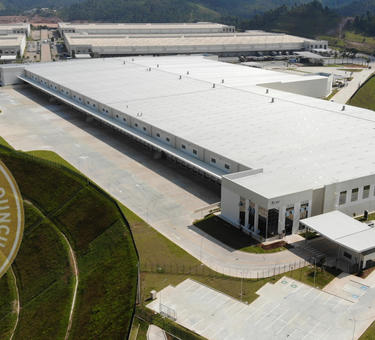At Prologis, we realize that our industrial warehouses and distribution centers have a lasting impact on the environment. For each logistics real estate facility we build or redevelop, we integrate sustainable design features and building practices, starting with the planning process and continuing throughout the life of the building.
While our motivation is to create efficient buildings for our customers and lasting value for our investors, we are deeply grateful for the recognition we’ve received from industry and third-party groups for our efforts. For the ninth consecutive year, Prologis was included on Corporate Knights’ Global 100, a list of the most sustainable corporations in the world. Corporate Knights conducts one of the most authoritative sustainability assessments, which is released annually at the World Economic Forum in Davos.
The U.S. Green Building Council (USGBC) established the Leadership in Energy and Environmental Design (LEED) rating system in 2000 to assess buildings against key sustainability standards, including energy conservation, indoor air quality, use of recycled and recyclable materials, support for reduced-carbon commuting options and long-term sustainability. LEED is the most widely used third-party verification standard for green buildings in the Americas. Public buildings, especially office buildings and educational and governmental facilities, are among the most frequent participants in the LEED certification program.
Prologis has been designing and developing LEED-certified buildings since 2006. In 2014, we partnered with USGBC and M.E. Group to use the LEED Volume Program to certify our development projects more efficiently. Prologis’ LEED Volume Program, which is used to certify all new core and shell projects in the Americas, demonstrates our industry-leading commitment to sustainability. Today, 18 of the 23 buildings in the eight-park Brazil portfolio have achieved LEED certification.
Sustainable Construction Practices
We give priority to materials of local origin, encouraging and supporting the regional market and reducing the impact and resources spent on transportation. With our projects in Brazil, at least 79 percent of construction waste is diverted from landfills, and 60 percent of construction materials are manufactured using recycled goods with 29 percent made or extracted regionally. Other sustainable design features include water-efficient landscaping and the use of low-VOC materials in paints and flooring systems to ensure a healthy environment for future occupants.
During the construction phase, we also implement an indoor air quality plan whenever possible to avoid compromising the interior environment. This system monitors and reduces dust and particulates to prevent the building materials from absorbing toxic chemicals.
Post-Occupancy Environmental Efforts
Good indoor air quality improves productivity because it is linked to the comfort and well-being of a building’s occupants. To ensure quality air, Prologis advises customers to install ventilation and air conditioning systems that comply with ASHRAE 62.1-2007. In addition, smoking is not allowed inside buildings or within 8 meters of all building entrances and windows on our properties.
With hundreds of thousands of workers commuting to a Prologis warehouse every day, access to public transit and green commute options are an ongoing effort. In Brazil, Prologis projects have bicycle parking areas, changing rooms and showers. About 5 percent of total vehicle parking places are reserved for low-emission vehicles and located near building entrances to encourage use.
On IMPACT Day, the same Friday in May each year, Prologis employees around the globe volunteer a full day of time in their communities. Read more about our IMPACT Day projects.
